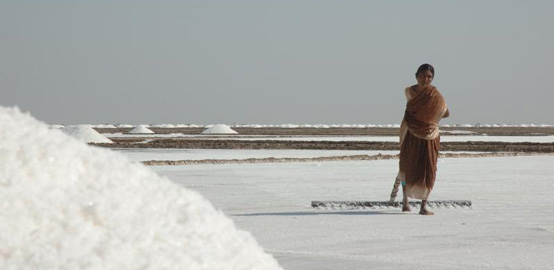Sun and Salt in Gujurat
If flying a quarter of the way around the planet doesn’t leave you a little dazed then what you find when you explore northern India certainly will. We went to Gujarat on a fact-finding mission, and returned with our notebooks (and senses) overflowing.

First, there were the physical symptoms: jet lag and sleeplessness operated with a push-me-pull-you disregard for my wristwatch, until I couldn’t work out if it was bedtime, afternoon or Christmas. Fortunately, our guides Mustakim and Deepak gently corralled us into the back of a 4×4 for the journey from Jamnagar to the Kush Highway. The 4×4 turned out to be essential kit when we came off the road and bumped through a village, with heaps of new brown bricks in buttressed stacks drying in the sunshine. When we rejoined the road, I even managed to close my eyes for a nap, and when we reached our destination, I felt refreshed, ready to stretch my legs, with my body clock confidently assuring me it was now early afternoon on a fine spring day at some point in the early 1980s.
India, the parts we saw anyhow, is a country of human industry. We didn’t pass a field without a cluster of labourers, or walk down a street without a rickshaw slowing next to us. On the back of a motorbike, I saw two boys tucked behind their father, doing their school homework. In contrast our destination was stark and desolate – we had reached the salt fields.
Salt is big news in India. There’s the industry itself: India is a huge player in the international salt market. Then there is the history: Gandhi’s march to the sea in order to make salt in defiance of the British Raj was a defining moment in India’s assertion of independence. And if Gandhi could’ve stood here with me and looked around, what would he see?
A weird, alien landscape, stretching out to the horizon under a relentlessly cloudless sky. Salt piled into hundred of barrows, surreal blocks of white in a desert. The air is still and silent, only a single bird, high up, wheeled around for a short time before realising its mistake and heading back to the green farms behind us. Miles from the sea, salty water is pumped out of the ground, and into flat, rectangular basins. As the water evaporates, the salt crystallises and glitters in the sunshine.
We found a well, a steep funnel driven into the grey earth, with a circular hole at the bottom. Noël ventured down, his head a good two feet below ground level when he reached the thick pipe that vanished into the manhole-sized opening at the centre.
When Noël came out from the well, we went to find some workers, who were sitting in the shade smoking. They were typically very friendly, answering our questions and telling us about their lives. There were five hundred wells on this salt plain, and the majority of work was done by hand, and by the sun. I watched a man and a woman working in an adjacent basin: he raked the salt into a bowl, which she carried on her head and added to one of the barrows. As far as the eye can see, the only signs of life are the workers and the occasional dog.
Four kilometres up the road, some momentous change in underground geography is revealed: here the groundwater isn’t salty and agriculture flourishes. It’s a startling moment to cross the divide from a dead land to a living one. Here the salt ends; there the trees begin to grow, birds nest in lush hedgerows, and a tractor plumes blue smoke as it rolls from field to field.
India needs her salt plains, of course, and Gandhi would be proud of her flourishing economy. But Noël and I were both aware with this sudden real-life example, that clean water has the capacity to transform some pretty hostile environments into viable ecosystems.
We had skipped breakfast, but my body clock is not easily fooled, and at 2.30pm, we gave in to our stomachs’ requests for what we confidently concluded was a midnight snack.
Tagged in: Gujurat, mitravitae, Salt fields
Your thoughts
21 January 2014 by ขี้ไก่
I really like it when people get together and share ideas.
Great blog, continue the good work!